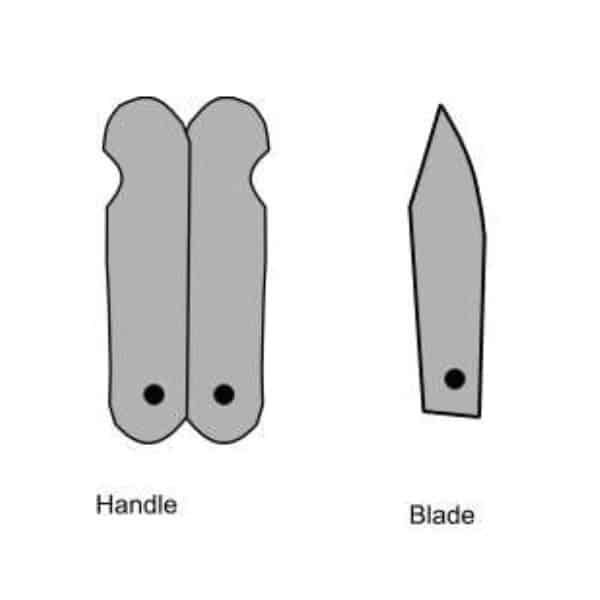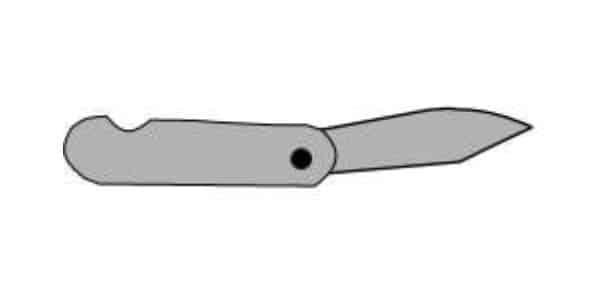
Make a Fake Pocketknife for Safety Demonstrations
A fake pocketknife made from cardboard is a great tool for teaching pocketknife safety to Cub Scouts. It helps Scouts learn the basics of handling a knife without the risk of injury. This is especially helpful when working on the knife safety adventures, where Scouts learn knife safety and carving skills. With the cardboard knife, Scouts can practice safely while gaining confidence.
This activity fits well into Cub Scout programs. It keeps Scouts engaged and gives them a hands-on way to learn. Before using real knives, Scouts can practice opening, closing, and handling their cardboard knife. Leaders can observe how well Scouts follow safety rules during the practice. This allows leaders to correct mistakes and reinforce good habits.
Using the fake knife helps prepare Scouts for real carving projects. When they practice with the cardboard knife first, they understand the motions and techniques they need to use. This makes the transition to using a real knife smoother and safer. It also builds trust that the Scouts are ready to handle real tools.
By introducing knife safety in this way, leaders create a safe learning environment. Scouts learn responsibility and respect for tools. The fake pocketknife activity helps them develop the skills and confidence they need to handle real pocketknives properly.
The Fake Pocketknife: Safety First, Cardboard Second
The idea of the fake pocketknife comes from a need to teach knife safety in a way that removes the risk of injury. For Cub Scouts, learning to use a knife is an important step in developing responsibility and outdoor skills. Leaders wanted a way for Scouts to practice safely before putting a real knife in their hands. The cardboard knife became the perfect solution.
This simple tool gives Scouts a chance to practice the motions of opening, closing, and carving without worrying about cuts. By using a fake knife, they can focus on learning the safety rules first. It also allows leaders to correct mistakes or bad habits early. Scouts can take their time to build confidence and skill before moving on to a real knife.
The fake pocketknife is also a nod to the Scouting value of being prepared. Scouts don’t jump straight into challenges. They practice and learn the right way to do things. The cardboard knife makes sure they are ready for the responsibility of handling a real knife. It’s a fun and safe step toward earning their knife safety adventure and learning a skill they will use for years to come.
What Scouts Will Learn from the Cardboard Pocketknife
This craft teaches Scouts a lot about knife safety before they ever touch a real knife. By practicing with a fake knife, they learn the right way to open and close a pocketknife. This helps them understand how a real knife works. It also shows them how to handle it carefully, step by step.
Scouts will learn how to hold the knife safely while pretending to carve. They will practice keeping their hands and fingers away from the blade. You can put lipstick or marker on the “blade” to show where mistakes happen. If they see marks on their hands, they’ll know they need to be more careful. This makes safety lessons clear and easy to understand.
This activity also teaches patience and focus. Scouts will realize that handling a knife takes care and attention. They will need to slow down and think about every move they make. This prepares them for carving with a real knife, where mistakes can lead to injuries.
Finally, Scouts learn responsibility. They see that a knife is a tool, not a toy. They learn to respect tools and follow safety rules. This craft helps them build confidence and shows them they can handle important skills when they are ready. By the time they move on to a real knife, they will know how to use it safely and responsibly.
Instructions
Materials Needed:
- Cardboard
- Scissors
- Brad (paper fastener)
- Hole punch or pencil (to make holes)
- Marker or pen (for tracing)
- Lipstick or washable marker (optional for safety practice)
Instructions:

- Cut Out the Handle and Blade
- Draw the shape of a pocketknife handle and blade on cardboard.
- The handle should be a single long piece that can fold in half.
- The shapes don’t need to be perfect, just roughly the size of a real pocketknife.
- Cut out the handle and the blade carefully using scissors.
- Punch the Holes
- Mark a dot near the end of the blade where it will attach to the handle.
- Fold the handle in half and mark dots where the blade will fit.
- Use a hole punch or carefully poke the holes with a pencil. Make sure the holes line up.
- Attach the Blade to the Handle
- Place the blade inside the folded handle so the holes line up.
- Insert the brad through all of the holes to connect the pieces.
- Flatten the ends of the brad to hold the pieces together securely.
- Test the “Knife”
- Open and close the cardboard knife to make sure it moves smoothly.
- Practice pretending to carve by moving the “blade” carefully as Scouts would with a real knife.

Notes for Leaders:
- Safety Practice: Put lipstick or washable marker on the edge of the blade. When Scouts “carve,” they can check their hands for marks to see if they’re holding or moving the knife unsafely.
- Reinforce Safety Rules: Use this craft as a chance to talk about proper knife safety, such as creating a “safety circle” and never using a knife toward yourself or others.
- Variations: If you don’t have brads, use a twist tie, string, or even a pipe cleaner to attach the blade. You can also decorate the handles to look more like real knives.
This simple craft makes knife safety fun, safe, and clear for Scouts. It prepares them for the responsibility of handling real tools.
More Resources

Crafts for Scouts
If you enjoyed making the Fake Pocketknife, you’ll find more great craft ideas for Scouts on my website. Crafts are a fun way for Scouts to learn new skills while staying engaged. Hands-on activities like this help them develop patience, focus, and responsibility.
Check out my Crafts for Scouts page for more ideas that work well in den meetings and other Scout activities. You’ll find crafts for all kinds of projects and learning opportunities. Whether you’re working on a specific skill or just looking for something creative, there’s something there for every group.
Frequently Asked Questions
Why use a fake pocketknife instead of a real one?
A fake pocketknife helps Scouts practice safely. It allows them to learn the motions of opening, closing, and carving without risk of injury. This builds their confidence before using a real knife.
What materials do I need to make the fake pocketknife?
You need cardboard, scissors, a brad (paper fastener), and something to punch holes. You can also use lipstick or a washable marker for safety practice.
How does the fake pocketknife teach knife safety?
Scouts learn how to handle a knife properly by practicing safe techniques. They can check for lipstick or marker marks on their hands to see where they might make mistakes. This helps them understand how to keep their hands safe.
Can I use this craft with younger Scouts?
Yes, this is great for Cub Scouts who are learning knife safety.
How long does it take to make the fake pocketknife?
It takes about 15-20 minutes to make. This includes cutting out the pieces and attaching the blade to the handle.
Do I need to use brads to attach the blade?
No, if you don’t have brads, you can use a twist tie, string, or pipe cleaner to hold the blade in place. Just make sure the blade can still move.
Can Scouts decorate their fake pocketknife?
Yes, Scouts can color or decorate the handle to make it unique. This makes the activity more fun while keeping the focus on safety.
Cutting Mistakes, Not Fingers
The Fake Pocketknife is a simple and safe tool to teach Cub Scouts about knife safety. Made from cardboard, it lets Scouts practice opening, closing, and holding a knife correctly. Leaders can use it to demonstrate safety techniques without the risk of cuts or injuries. This makes it perfect for introducing knife safety requirements in a fun and hands-on way.
Scouts learn important skills while using the Fake Pocketknife. They practice keeping their fingers away from the blade and holding it safely. Adding lipstick or marker to the “blade” makes the lesson even clearer. Scouts can check for marks on their hands, showing where they need to improve. This helps them understand how to carve safely before using a real knife.
The Fake Pocketknife also teaches Scouts patience and focus. It takes time to learn how to handle a knife properly. With the cardboard knife, Scouts can take their time to practice. Leaders can correct mistakes early and help Scouts feel confident before moving on to real carving projects.
This simple craft prepares Scouts for using real pocketknives responsibly. It helps them build confidence, learn safety rules, and gain the skills they need. By the time they move on to real knives, Scouts are ready to handle them carefully and safely.



Leave a Reply